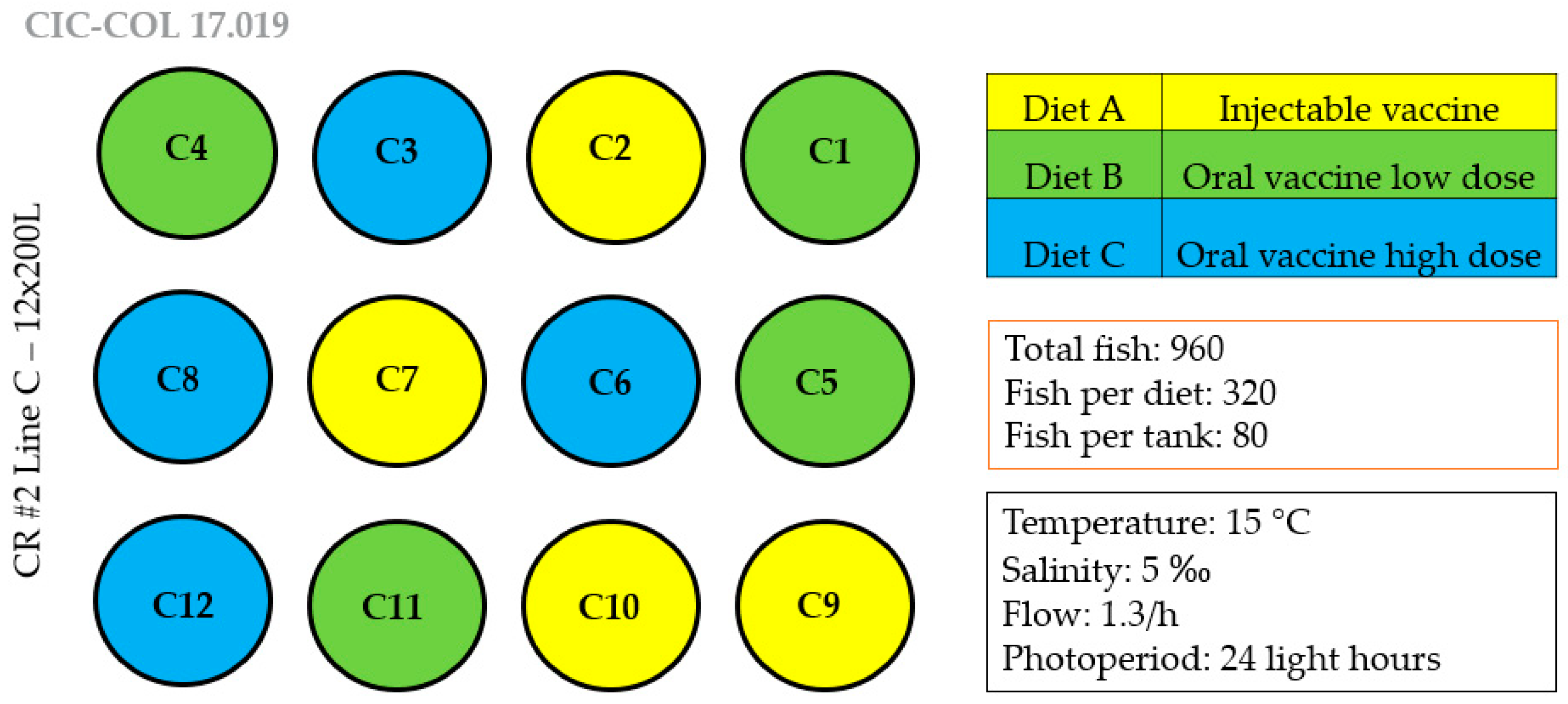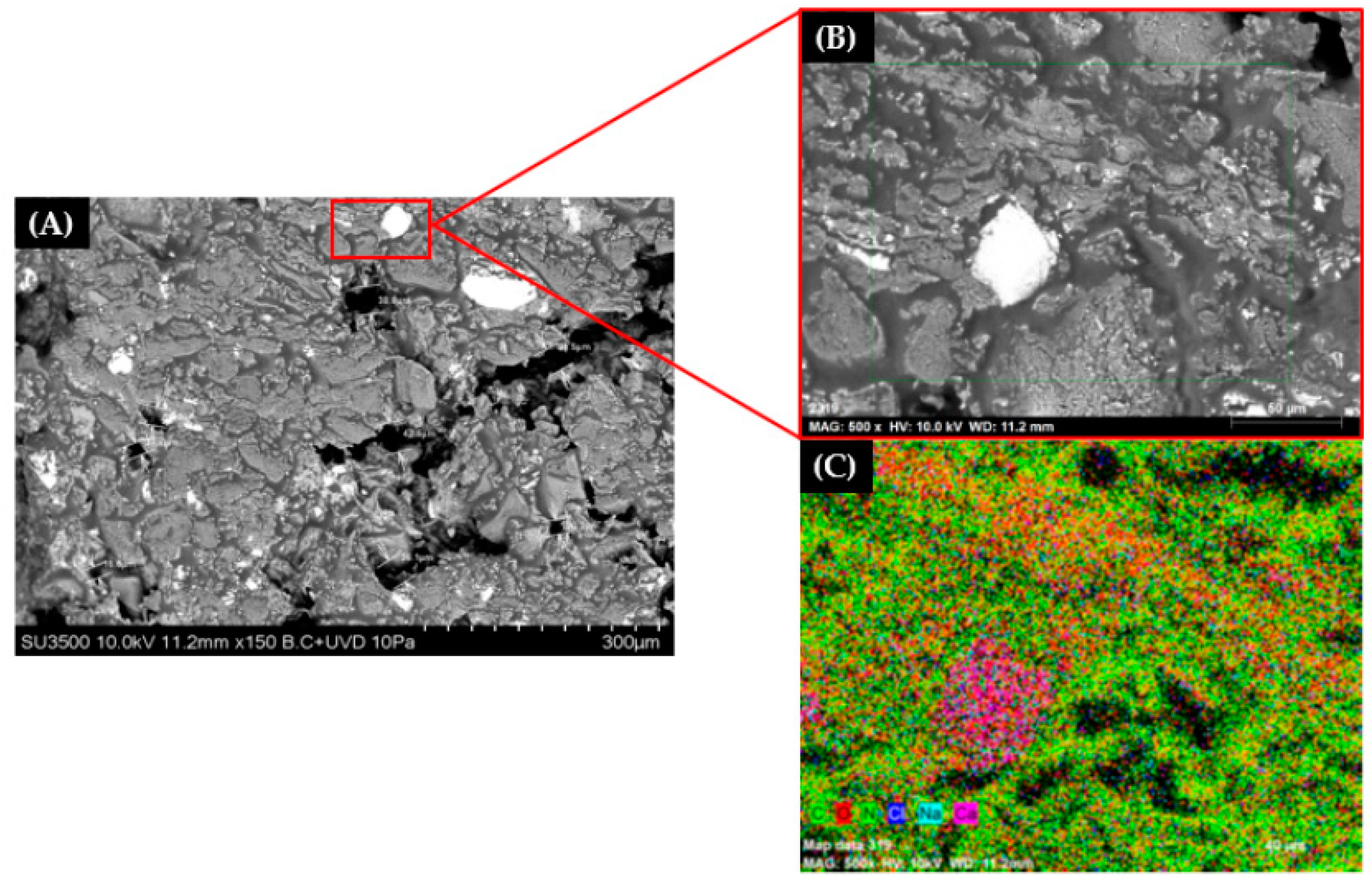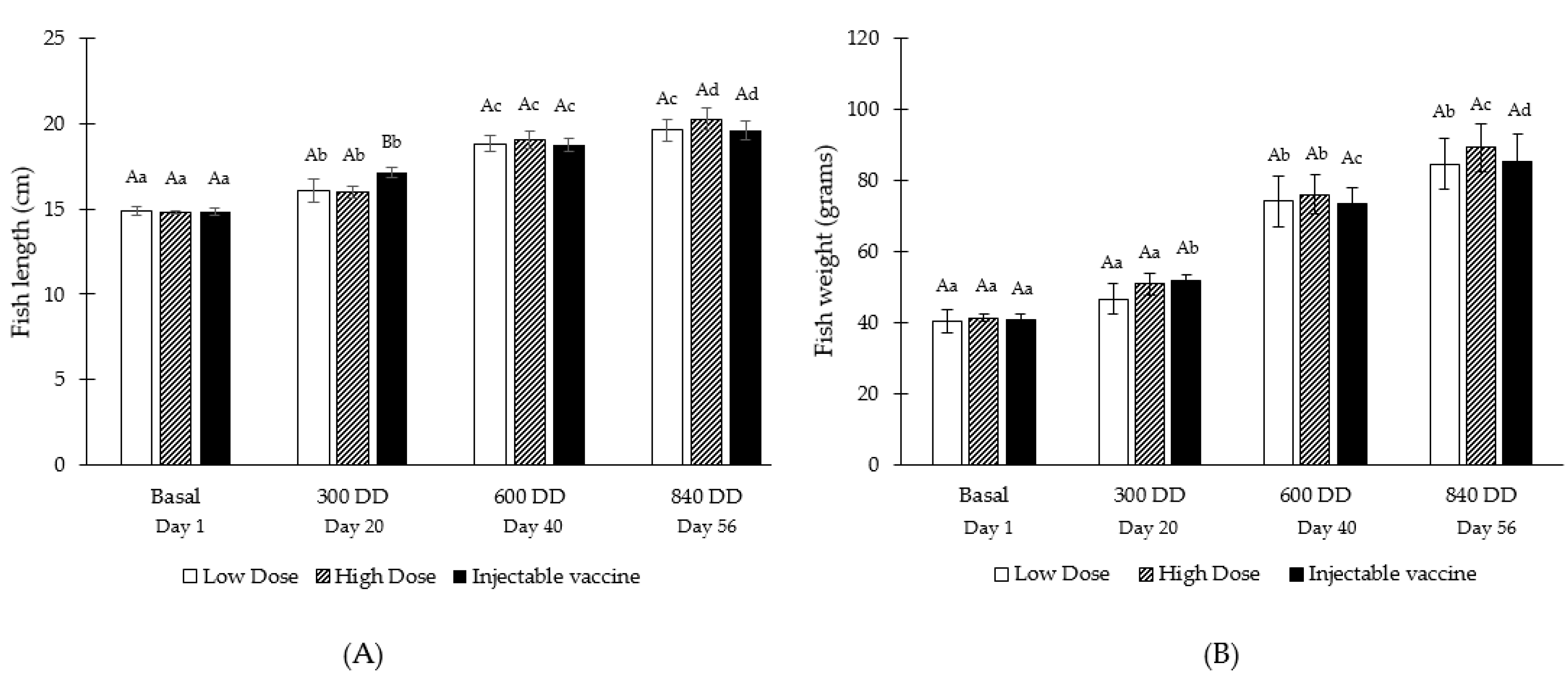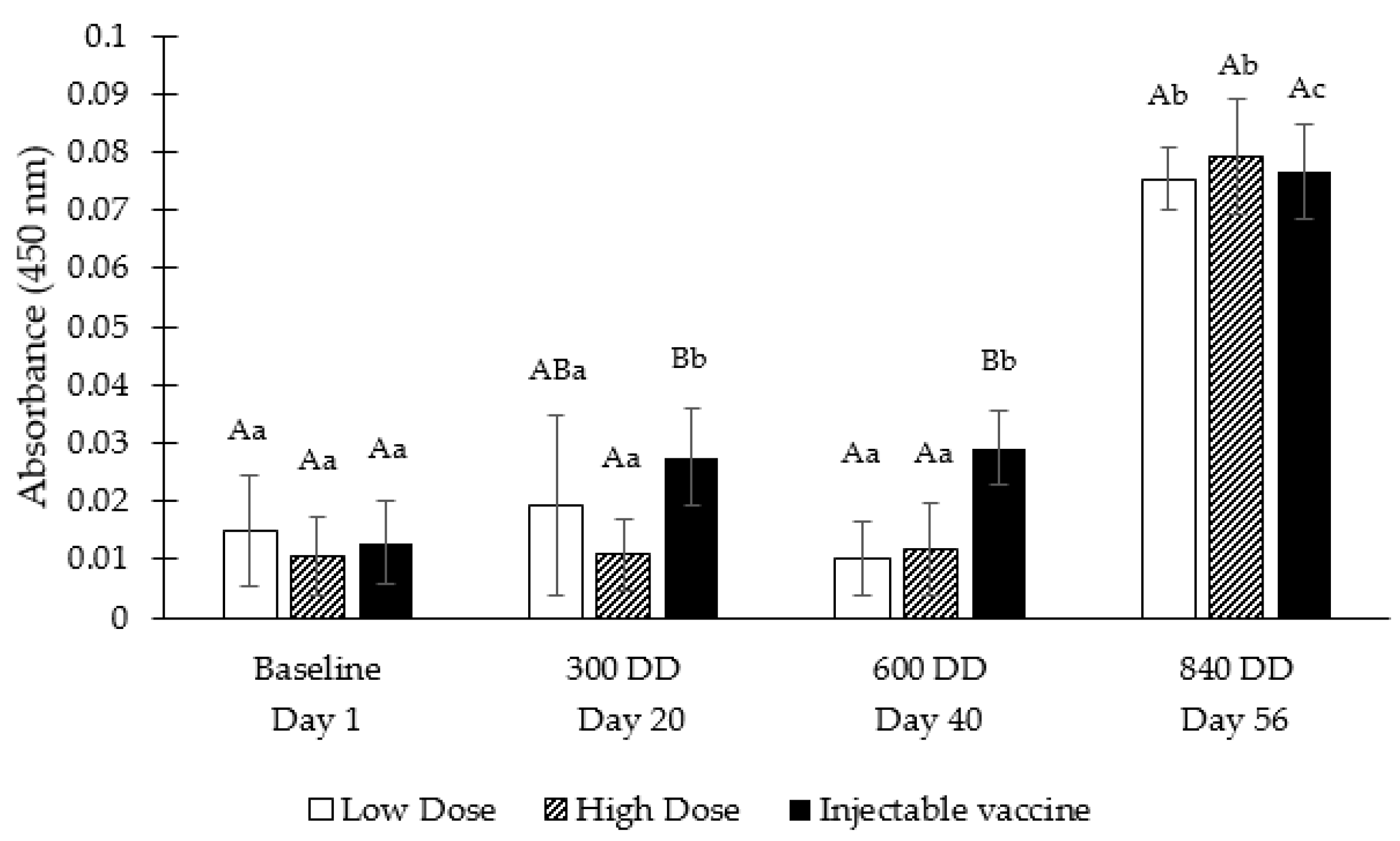Assessing the Immune Response of Atlantic Salmon (Salmo salar) after the Oral Intake of Alginate-Encapsulated Piscirickettsia salmonis Antigens
Abstract
1. Introduction
2. Materials and Methods
2.1. Ethics Statement
2.2. Oral Vaccine Preparation
2.2.1. Preparation of Alginate-Encapsulated P. salmonis Antigens (AEPSA)
2.2.2. Preparation of Feed Pellets Infused with Antigen Microparticles
2.3. Experimental Design
2.4. Feed Intake and Fish Growth Assessment
2.5. Effect of the Experimental Feed on the Immune System
2.6. Statistical Analysis
3. Results
3.1. Characterization of Microparticles and Incorporation in Fish Feed Pellets
3.2. Acceptability of the Experimental Feed and Its Effect on the Fish Growth
3.3. Effect of the Oral Vaccine on the Immune Response of Atlantic salmon
4. Discussion
5. Conclusions
Author Contributions
Funding
Acknowledgments
Conflicts of Interest
References
- Wilda, M.; Lavoria, M.Á.; Giráldez, A.; Franco-Mahecha, O.L.; Mansilla, F.; Érguiz, M.; Iglesias, M.E.; Capozzo, A.V. Development and preliminary validation of an antibody filtration-assisted single-dilution chemiluminometric immunoassay for potency testing of Piscirickettsia salmonis vaccines. Biologicals 2012, 40, 415–420. [Google Scholar] [CrossRef]
- Mardones, F.O.; Paredes, F.; Medina, M.; Tello, A.; Valdivia, V.; Ibarra, R.; Correa, J.; Gelcich. Identification of research gaps for highly infectious diseases in aquaculture: The case of the endemic Piscirickettsia salmonis in the Chilean salmon farming industry. Aquaculture 2018, 482, 211–220. [Google Scholar] [CrossRef]
- Lannan, C.N.; Fryer, J.L. Piscirickettsia salmonis, a major pathogen of salmonid fish in Chile. Fish. Res. 1993, 17, 115–121. [Google Scholar] [CrossRef]
- Fryer, J.L.; Hedrick, R.P. Piscirickettsia salmonis: A Gram-negative intracellular bacterial pathogen of fish. J. Fish. Dis. 2003, 26, 251–262. [Google Scholar] [CrossRef]
- Oliver, C.; Valenzuela, K.; Silva, H.; Haro, R.E.; Cortés, M.; Sandoval, R.; Pontigo, J.P.; Álvarez, C.; Figueroa, J.E.; Avendaño-Herrera, R.; et al. Effectiveness of egg yolk immunoglobulin against the intracellular salmonid pathogen Piscirickettsia salmonis. J. Appl. Microbiol. 2015, 119, 365–376. [Google Scholar] [CrossRef]
- Adelmann, M.; Kollner, B.; Bergmann, S.M.; Fischer, U.; Lange, B.; Weitschies, W.; Enzmann, P.J.; Fichtner, D. Development of an oral vaccine for immunisation of rainbow trout (Oncorhynchus mykiss) against viral haemorrhagic septicaemia. Vaccine 2008, 26, 837–844. [Google Scholar] [CrossRef]
- Mutoloki, S.; Munang’andu, H.M.; Evensen, Ø. Oral vaccination of fish—Antigen preparations, uptake, and immune induction. Front. Immunol. 2015, 6, 519. [Google Scholar] [CrossRef]
- Brudeseth, B.E.; Wiulsrød, R.; Fredriksen, B.N.; Lindmo, K.; Løkling, K.E.; Bordevik, M.; Steine, N.; Klevan, A.; Gravningen, K. Status and future perspectives of vaccines for industrialised fin-fish farming. Fish. Shellfish Immunol. 2013, 35, 1759–1768. [Google Scholar] [CrossRef]
- Ballesteros, N.A.; Rodriguez, S.; Perez-Prieto, S.I. Food pellets as an effective delivery method for a DNA vaccine against infectious pancreatic necrosis virus in rainbow trout (Oncorhynchus mykiss, Walbaum). Fish. Shellfish Immunol. 2014, 37, 220–228. [Google Scholar] [CrossRef]
- Rivas-Aravena, A.; Fuentes, Y.; Cartagena, J.; Brito, T.; Poggio, V.; La Torre, J.; Mendoza, H.; Gonzalez-Nilo, F.; Sandino, A.M.; Spencer, E. Development of a nanoparticle-based oral vaccine for Atlantic salmon against ISAV using an alphavirus replicon as adjuvant. Fish. Shellfish Immunol. 2015, 45, 157–166. [Google Scholar] [CrossRef]
- Caruffo, M.; Maturana, C.; Kambalapally, S.; Larenas, J.; Tobar, J. Protective oral vaccination against infectious salmon anaemia virus in Salmo salar. Fish. Shellfish Immunol. 2016, 54, 54–59. [Google Scholar] [CrossRef] [PubMed]
- Chen, L.; Klaric, G.; Wadsworth, S.; Jayasinghe, S.; Kuo, T.Y. Augmentation of the antibody response of Atlantic Salmon by oral administration of alginate-encapsulated IPNV antigens. PLoS ONE 2014, 9, e109337. [Google Scholar] [CrossRef] [PubMed]
- Reyes, M.; Ramirez, C.; Ñancucheo, I.; Villegas, R.; Schaffeld, G.; Kriman, L.; Gonzalez, J.; Oyarzun, P. A novel “in-feed” delivery platform applied for oral DNA vaccination against IPNV enables high protection in Atlantic salmon (Salmo salar). Vaccine 2017, 35, 626–632. [Google Scholar] [CrossRef] [PubMed]
- Tobar, J.A.; Jerez, S.; Caruffo, M.; Bravo, C.; Contreras, F.; Bucarey, S.A.; Harel, M. Oral vaccination of Atlantic salmon (Salmo salar) against salmonid rickettsial septicaemia. Vaccine 2011, 29, 2336–2340. [Google Scholar] [CrossRef] [PubMed]
- Kim, D.; Beck, B.R.; Lee, S.M.; Jeon, J.; Lee, D.W.; Lee, J.I.; Song, S.K. Pellet feed adsorbed with the recombinant Lactococcus lactis BFE920 expressing SiMA antigen induced strong recall vaccine effects against Streptococcus iniae infection in olive flounder (Paralichthys olivaceus). Fish. Shellfish Immunol. 2016, 55, 374–383. [Google Scholar] [CrossRef]
- Gao, P.; Xia, G.; Bao, Z.; Feng, C.; Cheng, X.; Kong, M.; Liu, Y.; Chen, X. Chitosan based nanoparticles as protein carriers for efficient oral antigen delivery. Int. J. Biol. Macromol. 2016, 91, 716–723. [Google Scholar] [CrossRef]
- Maurice, S.; Nussinovitch, A.; Jaffe, N.; Shoseyov, O.; Gertler, A. Oral immunization of Carassius auratus with modified recombinant A-layer proteins entrapped in alginate beads. Vaccine 2004, 23, 450–459. [Google Scholar] [CrossRef]
- Rodrigues, A.P.; Hirsh, D.; Figueiredo, H.C.P.; Logato, P.V.R.; Moraes, A.M. Production and characterisation of alginate microparticles incorporating Aeromonas hydrophila designed for fish oral vaccination. Process. Biochem. 2006, 41, 638–643. [Google Scholar] [CrossRef]
- Gudding, R.; Lillehaug, A.; Evensen, Ø. Recent developments in fish vaccinology. Vet. Immunol. Immunopathol. 1999, 72, 203–212. [Google Scholar] [CrossRef]
- Embregts, C.W.E.; Forlenza, M. Oral vaccination of fish: Lessons from humans and veterinary species. Dev. Comp. Immunol. 2016, 64, 118–137. [Google Scholar] [CrossRef]
- Plant, K.P.; Lapatra, S.E. Advances in fish vaccine delivery. Dev. Comp. Immunol. 2011, 35, 1256–1262. [Google Scholar] [CrossRef] [PubMed]
- Frey, A.; Giannasca, K.T.; Weltzin, R.; Giannasca, P.J.; Reggio, H.; Lencer, W.I.; Neutra, M.R. Role of the glycocalyx in regulating access of microparticles to apical plasma membranes of intestinal epithelial cells: Implications for microbial attachment and oral vaccine targeting. J. Exp. Med. 1996, 184, 1045–1059. [Google Scholar] [CrossRef] [PubMed]
- Neutra, M.R.; Kozlowski, P.A. Mucosal vaccines: The promise and the challenge. Nat. Rev. Immunol. 2006, 6, 148–158. [Google Scholar] [CrossRef] [PubMed]
- Fuglem, B.; Jirillo, E.; Bjerkås, I.; Kiyono, H.; Nochi, T.; Yuki, Y.; Raida, M.; Fischer, U.; Koppang, E.O. Antigen-sampling cells in the salmonid intestinal epithelium. Dev. Comp. Immunol. 2010, 34, 768–774. [Google Scholar] [CrossRef]
- Løkka, G.; Koppang, E.O. Antigen sampling in the fish intestine. Dev. Comp. Immunol. 2016, 64, 138–149. [Google Scholar] [CrossRef]
- Arumuganathar, S.; Suter, N.; Walzel, P.; Jayasinghe, S.N. Review. Aerodynamically assisted jetting and threading for processing concentrated suspensions containing advanced structural, functional and biological materials. Biotechnol. J. 2009, 4, 64–72. [Google Scholar] [CrossRef]
- Jayasinghe, N. Review. Biojets in regenerative biology & medicine. Mater. Today 2011, 14, 202–211. [Google Scholar] [CrossRef]
- Arumuganathar, S.; Jayasinghe, S.N. A versatile pressure assisted jet-fabrication by coating approach for forming biocompatible constructs for tissue engineering. Mater. Lett. 2008, 62, 2574–2577. [Google Scholar] [CrossRef]
- Anasac Chile S.A. Available online: https://www.anasac.cl/agropecuario/productos/providean-aquatec-1/ (accessed on 21 July 2020).
- Arumuganathar, S.; Jayasinghe, S.N.; Suter, N. Aerodynamically assisted jet processing of viscous single- and multi-phase media. Soft Matter 2007, 3, 605–612. [Google Scholar] [CrossRef]
- Sarker, P.K.; Kapuscinski, A.R.; Lanois, A.J.; Livesey, E.D.; Bernhard, K.P.; Coley, M.L. Towards sustainable aquafeeds: Complete substitution of fish oil with marine microalga Schizochytrium sp. improves growth and fatty acid deposition in juvenile Nile tilapia (Oreochromis niloticus). PLoS ONE 2016, 11, e0156684. [Google Scholar] [CrossRef]
- Birkbeck, T.H.; Rennie, S.; Hunter, D.; Laidler, L.A.; Wadsworth, S. Infectivity of a Scottish isolate of Piscirickettsia salmonis for Atlantic salmon Salmo salar and immune response of salmon to this agent. Dis. Aquat. Org. 2004, 60, 97–103. [Google Scholar] [CrossRef] [PubMed]
- Gibbs, B.F.; Kermasha, S.; Alli, I.; Mulligan, C.N. Encapsulation in the food industry: A review. Int. J. Food Sci. Nutr. 1999, 50, 213–224. [Google Scholar] [CrossRef] [PubMed]
- Arijo, S.; Brunt, J.; Chabrillon, M.; Díaz-Rosales, P.; Austin, B. Subcellular components of Vibrio harveyi and probiotics induce immune responses in rainbow trout, Oncorhynchus mykiss (Walbaum), against V. harveyi. J. Fish. Dis. 2008, 31, 579–590. [Google Scholar] [CrossRef] [PubMed]
- Ghosh, B.; Bridle, A.R.; Nowak, B.F.; Cain, K.D. Assessment of immune response and protection against bacterial coldwater disease induced by a live-attenuated vaccine delivered orally or intraperitoneally to rainbow trout, Oncorhynchus mykiss (Walbaum). Aquaculture 2015, 446, 242–249. [Google Scholar] [CrossRef]
- Altun, S.; Kubilay, A.; Ekici, S.; Didinen, B.I.; Diler, O. Oral vaccination against lactococcosis in rainbow trout (Oncorhynchus mykiss) using sodium alginate and poly (lactide-co-glycolide) carrier. Kafkas Univ. Vet. Fak. Derg. 2009, 16, 211–217. [Google Scholar] [CrossRef]
- Ballesteros, N.A.; Alonso, M.; Saint-Jean, S.R.; Perez-Prieto, S.I. An oral DNA vaccine against infectious haematopoietic necrosis virus (IHNV) encapsulated in alginate microspheres induces dose-dependent immune responses and significant protection in rainbow trout (Oncorrhynchus mykiss). Fish. Shellfish Immunol. 2015, 45, 877–888. [Google Scholar] [CrossRef]
- De las Heras, A.I.; Rodríguez, S.; Perez-Prieto, S.I. Immunogenic and protective effects of an oral DNA vaccine against infectious pancreatic necrosis virus in fish. Fish. Shellfish Immunol. 2010, 28, 562–570. [Google Scholar] [CrossRef]
- Zhang, J.; Li, X.; Zhang, D.; Xiu, Z. Theoretical and experimental investigations on the size of alginate microspheres prepared by dropping and spraying. J. Microencapsulation 2007, 24, 303–322. [Google Scholar] [CrossRef]
- Wolters, G.H.; Fritschy, W.M.; Gerrits, D.; Van Schilfgaarde, R. A versatile alginate droplet generator applicable for microencapsulation of pancreatic islets. J. Appl. Biomater. 1992, 3, 281–286. [Google Scholar] [CrossRef]
- Prusse, U.; Bilancetti, L.; Bucko, M.; Bugarski, B.; Bukowski, J.; Gemeiner, P.; Lewinska, D.; Manojlovic, V.; Massart, B.; Nastruzzi, C.; et al. Comparison of different technologies for alginate beads production. Chem. Zvesti 2008, 62, 364–374. [Google Scholar] [CrossRef]
- Klaric, G. Oral Delivery of Protein Antigens to Atlantic Salmon. Ph.D. Thesis, University College London, London, UK, 17 December 2015. Available online: https://core.ac.uk/download/pdf/79497908.pdf (accessed on 21 July 2020).
- Leong, J.Y.; Lam, W.; Ho, K.; Voo, W.; Lee, M.; Lim, H.; Lim, S.; Tey, B.; Poncelet, D.; Chan, E. Advances in fabricating spherical alginate hydrogels with controlled particle designs by ionotropic gelation as encapsulation systems. Particuology 2015, 24, 44–60. [Google Scholar] [CrossRef]
- Moradi, B.S.; Zolfagharian, H.; Mohamadpour, D.N.; Saraei, F.; Khaki, P.; Inanlou, F. Design and evaluate alginate nanoparticles as a protein delivery system. Arch. Razi. Inst. 2013, 68, 139–146. [Google Scholar] [CrossRef]
- Lai, K.K.; Renneberg, R.; Mak, W.C. High efficiency single-step biomaterial-based microparticle fabrication via template-directed supramolecular coordination chemistry. Green Chem. 2016, 18, 1715–1723. [Google Scholar] [CrossRef]
- Cvitanich, J.D.; Garate, O.N.; Smith, C.E. The isolation of Rickettsia-like organism causing disease and mortality in Chilean salmonids and its confirmation by Koch’s postulate. J. Fish. Dis. 1991, 14, 121–145. [Google Scholar] [CrossRef]
- Draganovic, V.; van der Goot, A.J.; Boom, R.; Jonkers, J. Wheat gluten in extruded fish feed: Effects on morphology and on physical and functional properties. Aquacult. Nutr. 2013, 19, 845–859. [Google Scholar] [CrossRef]
- Helgerud, T.; Gåserød, O.; Fjæreide, T.; Andersen, P.O.; Larsen, C.K. Alginates. In Food Stabilizers, Thickeners and Gelling Agents, 1st ed.; Imeson, A., Ed.; Blackwell Publishing Ltd.: Oxford, UK, 2010; pp. 50–72. [Google Scholar] [CrossRef]
- Joosten, P.H.M.; Tiemersma, E.; Threels, A.; Caumati-Dhiux, C.; Rombout, J.H.W.M. Oral vaccination of fish against Vibrio anguillarum using alginate microparticles. Fish. Shellfish Immunol. 1997, 7, 471–485. [Google Scholar] [CrossRef]
- Hordvick, I. Review. Immunoglobulin isotypes in Atlantic salmon, Salmo Salar. Biomolecules 2015, 5, 166–177. [Google Scholar] [CrossRef]
- Rombout, J.H.W.M.; van den Berg, A.A.; van den Berg, C.T.G.A.; Witte, P.; Egberts, E. Immunological importance of the second gut segment of carp. III. Systemic and/or mucosal immune responses after immunization with soluble or particulate antigen. J. Fish. Biol. 1989, 35, 179–186. [Google Scholar] [CrossRef]
- Weiner, H.L.; da Cunha, A.P.; Quintana, F.; Wu, H. Oral tolerance. Immunol. Rev. 2011, 241, 241–259. [Google Scholar] [CrossRef]





| Oral Vaccine | Total Doses/Fish | % of the RID/Fish | Dose/ Gram of Feed | Bacteria Cells/ Gram of Feed | Grams of Feed/ Day/Fish |
|---|---|---|---|---|---|
| Low dose | 3 | 30% | 0.44 | 4.4 × 107 | 0.68 |
| High dose | 10 | 100% | 1.33 | 1.33 × 108 | 0.75 |
| Oral Vaccine | Number of Doses for 5 kg of Feed | Antigen Volume (mL) | Alginate Solution (mL) | Distilled Water (mL) | Total Polymeric Solution (mL) |
|---|---|---|---|---|---|
| Low dose | 2206 | 6.6 | 36 | 17.4 | 60 |
| High dose | 6667 | 20 | 36 | 4 | 60 |
| Group | Feed Intake (%) during Vaccination Period | Feed Intake (%) during the Entire Trial |
|---|---|---|
| Low dose | 100 a | 95.23 ± 1.83 a |
| High dose | 100 a | 94.02 ± 3.87 a |
| Injectable vaccine | 100 a | 90.81 ± 2.93 a |
| Group | Weight Gain (grams) | Length Gain (cm) | SGR (%/day) |
|---|---|---|---|
| Low dose | 44.12 ± 5.59 a | 4.77 ± 0.36 a | 1.37 ± 0.12 a |
| High dose | 47.93 ± 7.40 a | 5.48 ± 0.73 a | 1.42 ± 0.17 a |
| Injectable vaccine | 44.20 ± 8.45 a | 4.78 ± 0.77 a | 1. 35 ± 0.20 a |
| p-value | 0.706 | 0.219 1 | 0.816 |
© 2020 by the authors. Licensee MDPI, Basel, Switzerland. This article is an open access article distributed under the terms and conditions of the Creative Commons Attribution (CC BY) license (http://creativecommons.org/licenses/by/4.0/).
Share and Cite
Sotomayor-Gerding, D.; Troncoso, J.M.; Pino, A.; Almendras, F.; Diaz, M.R. Assessing the Immune Response of Atlantic Salmon (Salmo salar) after the Oral Intake of Alginate-Encapsulated Piscirickettsia salmonis Antigens. Vaccines 2020, 8, 450. https://doi.org/10.3390/vaccines8030450
Sotomayor-Gerding D, Troncoso JM, Pino A, Almendras F, Diaz MR. Assessing the Immune Response of Atlantic Salmon (Salmo salar) after the Oral Intake of Alginate-Encapsulated Piscirickettsia salmonis Antigens. Vaccines. 2020; 8(3):450. https://doi.org/10.3390/vaccines8030450
Chicago/Turabian StyleSotomayor-Gerding, Daniela, José Miguel Troncoso, Alejandro Pino, Felipe Almendras, and Mónica Rubilar Diaz. 2020. "Assessing the Immune Response of Atlantic Salmon (Salmo salar) after the Oral Intake of Alginate-Encapsulated Piscirickettsia salmonis Antigens" Vaccines 8, no. 3: 450. https://doi.org/10.3390/vaccines8030450
APA StyleSotomayor-Gerding, D., Troncoso, J. M., Pino, A., Almendras, F., & Diaz, M. R. (2020). Assessing the Immune Response of Atlantic Salmon (Salmo salar) after the Oral Intake of Alginate-Encapsulated Piscirickettsia salmonis Antigens. Vaccines, 8(3), 450. https://doi.org/10.3390/vaccines8030450






